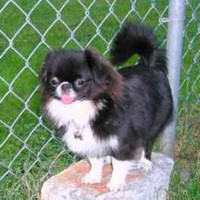Appearance of the Jatzu
|
| Hybrid dogs are a mixture of two breeds, and as such, their physical appearance is something of a lottery. While some puppies may strongly resemble one of the parents, others exist on a spectrum that merges the two. However, the breeds of both parents are small in stature but with long, luxurious coats. Therefore, it's not unreasonable to assume that a Jatzu will also share these characteristics. The dog's silhouette can vary, from the longer, stockier shape of the Shih Tzu to the smaller, folded appearance of the Japanese Spaniel. This is also the case with their heads, which vary from the rounded, apple-shaped face of the Shih Tzu to the flat, doll-like face of the Japanese Spaniel. Their coat is guaranteed to be long and luxurious, with a tail held proudly curled over their back. Colors vary widely, most likely a combination of cream and gold, apricot, black or brown. |
Temperament of the Jatzu
|
| The original parent breeds were specifically designed to be polite, peaceful companions of the nobility. They both excelled in this area, so it's a reasonable assumption that the Jatzu does too. Described by words like gentle, intelligent and loyal, these dogs are lovers rather than fighters, and aspire to the quiet life. This trait, along with their small size, means they don't like to be treated roughly. They don't mix well with energetic children, and much prefer a cuddle to an energetic game of ball. They may also have a strong-willed, stubborn streak, which means their owners need to be patient when potty training them. |
Needs and activities of the Jatzu
|
| Although this small dog tends to be lively and energetic, it is generally able to expend this energy with relatively little effort on your part. While this crossbreed will appreciate short walks around the neighborhood, it's best to give them short breaks every twenty minutes or so. It's particularly important to remember that if your hybrid only has a single layer of hair, it may be more sensitive to cold temperatures, and if you live in a colder climate, sweaters and jackets designed for your canine companion will probably be a good investment, and their short, wide muzzles can make them more vulnerable to overheating, so exercise shouldn't be too tiring in hot weather. Puzzles and toys designed for dogs and games of hide-and-seek can help keep the Jatzu's lively, active mind occupied, and they generally make pleasant household companions, even in smaller spaces. |
Maintenance of the Jatzu
|
| Depending on the qualities of the coat inherited by the Jatzu, it may have fairly extensive cleaning requirements, or require only a modest daily time commitment. Both parent breeds should be bathed every three to four weeks, as should the Jatzu. The Japanese Spaniel has a medium-length single-layer coat with a silky texture, and the Shih Tzu has a double-layer coat made up of a soft, short undercoat and a layer of long, smooth, silky hairs that tangle. The Jatzu with a coat resembling that of the shorter Japanese Spaniel is generally the least complicated to groom, but still needs to be brushed and combed several times to remove tangles and braids. The Shih Tzu's longer double coat is even more prone to tangling than the Japanese Spaniel's coat, and requires either trimming of the short coat or tedious daily grooming. The Japanese Spaniel and Shih Tzu breeds tend to shed less than other dogs and have been classified as hypoallergenic. Jatzu dogs share this classification. |









 English (United Kingdom)
English (United Kingdom)